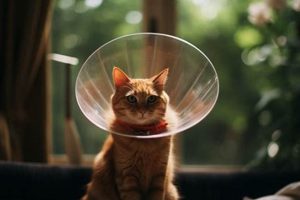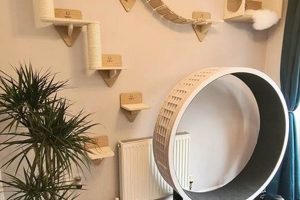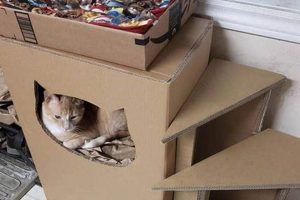A domestic feline’s well-being can be monitored proactively through owner-conducted examinations at home. This involves regular observation and simple physical assessments performed by the cat’s caregiver, focusing on key indicators of health. For example, owners can routinely check their cat’s eyes for discharge, their coat for parasites, and their gums for healthy color.
Consistent at-home assessments offer numerous advantages. They enable early detection of potential health issues, allowing for timely veterinary intervention and potentially preventing the escalation of minor problems into serious conditions. Historically, observant pet owners have always played a role in safeguarding their animal companions’ health, and this practice modernizes and refines that traditional commitment to care.
The following sections will detail specific areas for observation, methods for conducting basic physical examinations, and guidance on when to seek professional veterinary advice based on the findings of these home assessments.
Guidance for At-Home Feline Wellness Monitoring
Proactive observation is crucial for maintaining a cat’s optimal health. Consistent home assessments, performed carefully and regularly, can reveal early signs of illness, enabling timely veterinary care.
Tip 1: Conduct Regular Weight Checks: A sudden gain or loss in weight, even without apparent changes in appetite, can indicate underlying health problems. Utilize a household scale and maintain a record of weight fluctuations.
Tip 2: Evaluate Hydration Levels: Gentle skin tenting (lifting the skin at the scruff) provides an assessment of hydration. Skin that returns slowly may suggest dehydration, requiring increased water intake or veterinary attention.
Tip 3: Observe Litter Box Habits: Note any changes in urine or stool volume, frequency, or consistency. Blood in the urine or feces, straining to urinate or defecate, or diarrhea warrant immediate veterinary consultation.
Tip 4: Inspect the Oral Cavity: Examine the gums for redness, swelling, or bleeding. Bad breath and excessive drooling can also signify dental issues, necessitating professional dental cleaning or treatment.
Tip 5: Assess Respiratory Rate and Effort: While at rest, count the number of breaths per minute. Increased respiratory rate or labored breathing (wheezing, coughing) requires prompt veterinary evaluation.
Tip 6: Palpate for Lumps or Bumps: Gently run hands over the cat’s body, noting any new or growing lumps or bumps. These may be benign, but require assessment by a veterinarian to rule out serious conditions.
Tip 7: Observe Behavior and Activity Levels: Note any changes in activity levels, appetite, or interactions with owners or other pets. Lethargy, loss of appetite, or hiding can indicate illness or pain.
Consistent application of these monitoring techniques allows for a comprehensive understanding of a cat’s baseline health. Deviation from these baselines should prompt further investigation.
The subsequent section will detail how to document these observations effectively and when to seek professional guidance based on the findings.
1. Baseline Vital Signs
Baseline vital signs represent a fundamental component of at-home feline health monitoring. These initial measurements serve as a comparative benchmark against which subsequent assessments are evaluated. Without established baselines, deviations indicative of underlying health issues may go unnoticed during routine owner-conducted examinations. For example, a cat’s normal resting respiratory rate, typically between 16 and 40 breaths per minute, must be known to identify an elevated rate that could signal respiratory distress. Similarly, a healthy gum color provides a standard for detecting pallor or jaundice, potential signs of anemia or liver disease.
The process of establishing baseline vital signs involves systematically measuring and recording key physiological parameters when the cat is demonstrably healthy and unstressed. This includes body temperature (taken rectally), heart rate (auscultated or palpated), respiratory rate (observed), and gum color (visually inspected). Body weight should also be recorded and regularly monitored. Documenting these measurements allows for the tracking of subtle changes over time, enabling early detection of health problems that might otherwise be overlooked. A sudden increase in body temperature, for instance, could indicate an infection, while a gradual weight loss might suggest a chronic condition.
In summary, understanding and diligently recording baseline vital signs is an essential first step in effective at-home feline health monitoring. This proactive approach empowers owners to detect subtle health changes early, facilitating timely veterinary intervention and potentially improving the long-term health and well-being of their feline companions. The practice necessitates careful observation and consistent record-keeping to ensure accurate comparisons and informed decision-making regarding veterinary care.
2. Behavioral Observations
Behavioral observations represent a crucial, yet often underestimated, component of at-home feline health assessments. Subtle shifts in a cat’s behavior frequently serve as early indicators of underlying medical conditions, preceding more overt physical symptoms. Diligent monitoring of these behavioral nuances allows owners to proactively identify potential health issues and seek timely veterinary care.
- Changes in Appetite
A sudden decrease or increase in appetite, or the development of finicky eating habits, can indicate a range of medical conditions, from dental pain to systemic illness. Observing whether a cat consistently finishes meals, rejects preferred foods, or exhibits increased interest in food without subsequent weight gain offers valuable diagnostic clues. Sustained changes warrant veterinary investigation.
- Altered Activity Levels
Marked changes in activity levels, such as increased lethargy or restlessness, should be carefully noted. A previously playful cat becoming withdrawn and inactive may be experiencing pain or discomfort. Conversely, increased pacing or vocalization could signal hyperthyroidism or cognitive dysfunction. These deviations from normal activity patterns provide critical information for veterinary assessment.
- Changes in Social Interaction
Alterations in a cat’s interactions with household members or other pets can signify health problems. A cat that suddenly becomes reclusive or aggressive towards familiar individuals might be experiencing pain or anxiety. Conversely, increased clinginess or attention-seeking behavior could indicate a neurological issue or a need for increased comfort due to illness. Careful observation of these social dynamics is essential for comprehensive health monitoring.
- Changes in Grooming Habits
Significant changes in grooming behavior, either increased or decreased, can indicate underlying health concerns. Overgrooming, particularly in specific areas, may suggest skin allergies, pain, or stress. Neglect of grooming can result from dental pain, arthritis, or other debilitating conditions. Monitoring the frequency and thoroughness of grooming provides important insights into a cat’s physical and emotional well-being.
These facets of behavioral observation collectively enhance the efficacy of at-home feline health monitoring. By diligently noting these subtle yet informative behavioral changes, owners contribute significantly to the early detection and management of feline health problems, ultimately promoting the long-term health and quality of life for their feline companions. This proactive approach complements routine veterinary checkups and empowers owners to become active participants in their cat’s healthcare.
3. Physical Examination
The practice of owner-conducted physical examinations constitutes a critical component within a “diy cat health checkup” protocol. This hands-on assessment allows for the early detection of abnormalities not readily apparent through simple observation of behavior or appetite. A systematic physical review, regularly performed, serves as a preventative measure, enabling timely intervention for nascent health concerns. For example, a careful palpation of the abdomen may reveal previously unnoticed masses, while an examination of the oral cavity can identify dental disease before it significantly impacts the animal’s well-being.
The importance of the physical examination within the context of the “diy cat health checkup” stems from its ability to provide tangible data on the animal’s physiological state. This data, when combined with behavioral observations and baseline vital signs, creates a comprehensive picture of the cat’s health. Furthermore, familiarizing oneself with the normal physical characteristics of a cat allows for easier identification of deviations from the norm. Consider, for instance, the assessment of skin turgor to evaluate hydration status; knowing the normal elasticity of the skin provides a basis for recognizing dehydration more readily. This early recognition directly impacts the efficacy of subsequent veterinary consultations and treatment plans.
In conclusion, the physical examination provides critical, tangible insights into feline health, making it an indispensable element of a comprehensive “diy cat health checkup.” While not a replacement for professional veterinary care, this practice empowers owners to proactively monitor their cats well-being and detect potential health issues early, thus enhancing the animal’s quality of life and potentially reducing the need for extensive or invasive interventions. Owners should, however, be fully aware of their skill limitations and consult with a veterinarian if any concerns are raised.
4. Nutrition Monitoring
Nutrition monitoring constitutes an indispensable component of a thorough at-home feline health assessment. A cat’s diet directly impacts its overall health, and alterations in eating habits or body condition often serve as early indicators of underlying medical conditions. Consistent observation and documentation of dietary intake, along with assessment of body weight and muscle mass, provide crucial insights into the animal’s well-being. For instance, a sudden decrease in food consumption may signal dental pain, gastrointestinal issues, or systemic illness. Conversely, an increased appetite coupled with weight loss could indicate hyperthyroidism or diabetes. Ignoring these nutritional cues can delay diagnosis and potentially exacerbate underlying health problems. Proper nutrition also play a important role.
Effective nutrition monitoring within the context of a “diy cat health checkup” involves several key practices. First, diligent record-keeping of food type, quantity, and frequency of feeding is essential. This allows for the tracking of caloric intake and identification of any changes in dietary preferences. Second, regular weight checks provide valuable information about the cat’s nutritional status. Gradual weight loss or gain, even without obvious changes in appetite, should prompt further investigation. Third, body condition scoring, a technique involving palpation of the ribs and assessment of muscle mass, offers a subjective but informative evaluation of the cat’s overall nutritional health. These combined practices allow for prompt identification of possible nutrition related health risks.
In summary, conscientious nutrition monitoring is a proactive measure that empowers owners to detect potential health issues early through changes in their cat’s eating habits or body condition. This proactive approach, integrated within a more comprehensive “diy cat health checkup” regimen, enables timely veterinary intervention and promotes optimal health and longevity for the feline companion. Failure to adequately monitor nutritional intake may result in delayed diagnosis and management of treatable conditions, thereby compromising the animal’s well-being. Therefore, an awareness of nutrition is a very important factor in cat health.
5. Environmental Safety
Environmental safety plays a crucial role in preventive feline healthcare, directly impacting the efficacy and scope of any owner-initiated health monitoring efforts. A safe and secure environment minimizes the risks of injury, poisoning, and stress, thereby reducing the likelihood of health problems that require veterinary intervention. A proactive approach to environmental hazard mitigation complements and enhances the value of regular at-home health checks.
- Toxic Substances
Household chemicals, certain plants, and medications pose significant risks to cats. Ingestion or exposure can lead to a variety of health problems, ranging from gastrointestinal upset to organ damage. Securely storing all potentially toxic substances and identifying poisonous plants within the home and garden is essential. Symptoms resulting from poisoning can mimic other ailments, making accurate diagnosis during a “diy cat health checkup” challenging if the exposure goes unnoticed.
- Physical Hazards
Common household items such as electrical cords, loose strings, and small objects can present choking or entanglement hazards. Ensuring that these items are secured or removed minimizes the risk of injury. Falls from heights, particularly from unsecured windows or balconies, can also cause trauma. Early detection of internal injuries following a fall may be difficult without professional veterinary assessment; therefore, prevention is paramount.
- Stressors
A stressful environment can negatively impact a cat’s immune system and overall health. Loud noises, aggressive pets, and lack of safe spaces can all contribute to chronic stress. Minimizing these stressors and providing ample opportunities for rest and relaxation are crucial. Signs of stress, such as hiding or changes in appetite, can overlap with symptoms of other illnesses, complicating the interpretation of findings during a “diy cat health checkup”.
- Parasite Prevention
Fleas, ticks, and other parasites can transmit diseases and cause skin irritation. Regular use of appropriate preventative medications and diligent cleaning of the environment can minimize the risk of infestation. Recognizing the signs of parasitic infection, such as excessive scratching or hair loss, is an important aspect of at-home health monitoring, but environmental control is the first line of defense.
By proactively addressing potential environmental hazards, owners can create a safer living space for their cats, reduce the risk of illness and injury, and enhance the reliability of the observations made during a “diy cat health checkup”. A safe environment simplifies the detection of true health problems by minimizing the potential for environmental factors to confound the diagnostic process. Environmental safety is a fundamental, often overlooked, aspect of preventative feline healthcare.
Frequently Asked Questions
This section addresses common queries regarding owner-conducted health monitoring of domestic cats. The information is intended to supplement, not replace, professional veterinary care.
Question 1: Is a “diy cat health checkup” a substitute for veterinary examinations?
No. Owner-initiated health monitoring serves as a supplement to, not a replacement for, regular veterinary checkups. Professional veterinary examinations provide comprehensive diagnostic capabilities and access to treatments unavailable for home administration. At-home assessments facilitate early detection of potential issues, prompting timely veterinary consultation.
Question 2: How often should a “diy cat health checkup” be performed?
The frequency depends on the cat’s age, health status, and lifestyle. For healthy adult cats, a monthly assessment is generally adequate. Senior cats or those with chronic conditions may benefit from more frequent monitoring, as directed by a veterinarian. Any observed changes should prompt immediate evaluation.
Question 3: What tools or equipment are needed for a “diy cat health checkup”?
Minimal equipment is required. A household scale, thermometer (rectal), stethoscope (optional), and a notepad for recording observations are generally sufficient. Maintaining a comprehensive health record is essential for tracking changes over time.
Question 4: How can an owner accurately assess gum color during a “diy cat health checkup”?
Gently lift the cat’s upper lip and observe the color of the gums. Healthy gums should be pink. Pale gums may indicate anemia, while bluish gums can suggest respiratory distress. Yellowish gums can be a sign of jaundice and should be assessed immediately.
Question 5: What signs during a “diy cat health checkup” should prompt immediate veterinary attention?
Difficulty breathing, severe lethargy, inability to urinate or defecate, significant bleeding, seizures, and any signs of severe pain warrant immediate veterinary evaluation. Delaying treatment can lead to serious complications or death.
Question 6: Are there resources available to help owners conduct a “diy cat health checkup” more effectively?
Numerous reputable online resources, including veterinary websites and educational materials, provide guidance on conducting at-home health assessments. Consulting with a veterinarian to receive personalized instructions tailored to the cat’s specific needs is highly recommended.
Regular at-home health assessments provide owners with valuable insight into their cat’s health status, contributing to early detection and management of potential health problems.
The following section will provide a conclusion and summary of the benefits of these checks.
Conclusion
The preceding exploration of “diy cat health checkup” underscores its significance as a proactive approach to feline healthcare. This method empowers owners to take a more active role in monitoring their cats well-being, facilitating the early detection of potential health issues. From establishing baseline vital signs and observing behavioral changes to conducting physical examinations and ensuring environmental safety, the comprehensive application of these techniques can improve health outcomes.
The conscientious implementation of “diy cat health checkup” practices, while not a substitute for professional veterinary care, promotes a greater understanding of a feline companion’s health status. Vigilance in observing and recording relevant data enables owners to make informed decisions regarding veterinary consultations and treatment plans, ultimately contributing to a higher quality of life and prolonged longevity for their feline companions. Continued dedication to preventive care remains paramount in safeguarding animal welfare.







